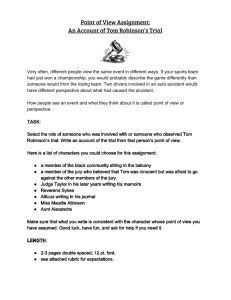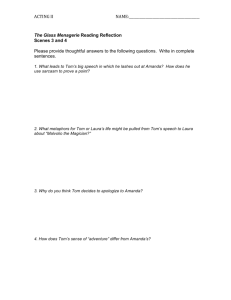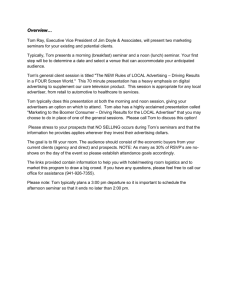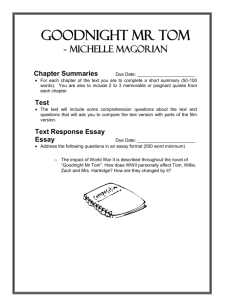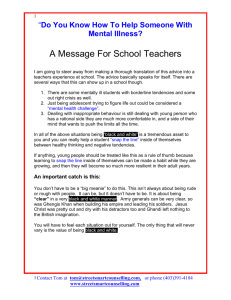evidence
advertisement
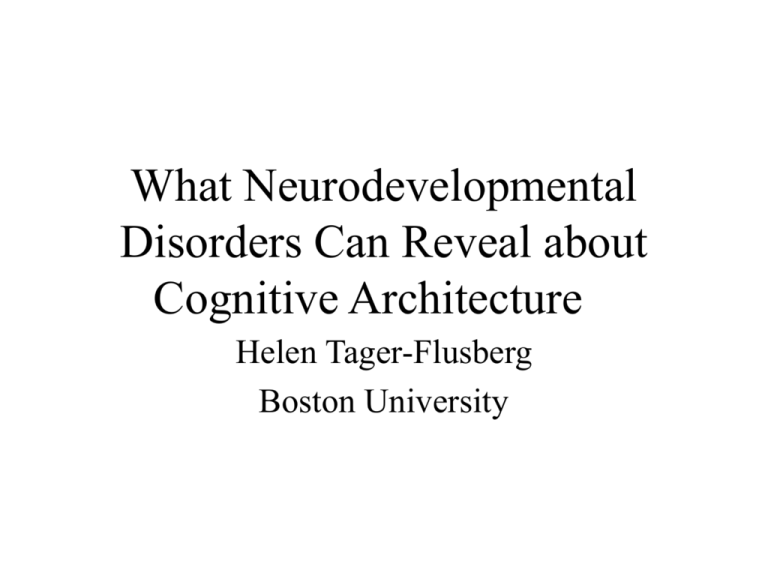
What Neurodevelopmental Disorders Can Reveal about Cognitive Architecture Helen Tager-Flusberg Boston University Outline • Discussion of whether neurodevelopmental disorders has potential to inform debates about cognitive architecture (methodological issues and complications) • Example of research on theory on mind in NDD: autism and Williams syndrome • Reinterpretation of the classical evidence Defining Neurodevelopmental Disorders (NDD) • Focus on genetically-based NDD • NDD divide into gene/chromosome disorders (e.g., Down, Turner, Williams, PKU) and polygenic/complex disorders (e.g., autism, SLI) • Genetic abnormalities (absence, mutation) disrupt normal development of brain • Lead to different ‘phenotypes’ that are syndrome specific Role of Disorders in Cognitive Science • Lengthy tradition of using data from people with brain/cognitive damage to inform cognitive theory, and organization of cognitive system • Examples from aphasia, amnesia, agnosia etc. • A for Acquired disorders - provides rich information about dissociations between cognitive modules from the “end state” Can Individuals with Abnormal Brain DEVELOPMENT Inform Cognitive Science? • Disruption in brain development affects the ACQUISITION of cognitive systems • Studies thus provide data on developmental processes; can study end state of this developmental process in adults with NDD • Controversial whether NDD can provide evidence about cognitive architecture, even from a developmental perspective Arguments Against: KarmiloffSmith (1998) • Because brains develop DIFFERENTLY in NDD – But little evidence for major differences in developmental processes – Not a logical argument against using NDD evidence Arguments Against (contd 2) • NDD does not create localized lesion; no simple intact/impaired cortical circuits that map directly onto cognitive modules – May be true for some disorders but not others – Depend on the NDD, the cognitive system, the individual Arguments Against (contd 3) • Developmental changes in the phenotype lead to fundamentally different organization; plasiticity in structure /function – Data on phenotypic changes from infancy are controversial and suspect – Plasticity is highly constrained; the brain is not a blank slate! Alternative View • Arguments proposed by K-S not compelling. • May depend on which NDD investigate • Striking difference in children with different NDD - and subgroups within syndromes • Depends on which cognitive module • Identifying specific cognitive module that has been disrupted in NDD has been elusive Methodological Issues in Studying NDD • Heterogeneity in expression of phenotype within each syndrome – Individual differences related to genetic variation related to NDD – Individual differences related to genetic variation NOT related to NDD • Differences related to experience – Age effects – Remediation/Compensation Effects of Retardation and Language Limitations • Task performance will be a function of – MR (g - cognitive efficiency?) - non-modular influences – Language (comprehend instructions; task content) • These effects will potentially obsure syndrome-specific effects on cognitive module • At the least, include subjects in limited age range, measures of IQ and language ability Example: Theory of Mind (ToM) • Since ToM entered the cognitive ‘cannon’ evidence from NDD has been central in arguments about its organization, modularity and innateness • Classic studies of autism; more recent studies of other syndromes e.g., Williams ToM in Autism • Baron-Cohen, Leslie & Frith (1985) demonstrated failure on FB • Many studies replicate their findings on FB and other related tasks; compared to control subjects and control tasks • Support for view of selective impairment to ToM in autism • Taken as evidence that ToM in unitary module under genetic influence with unique neurobiological substrate Significance of ToM Hypothesis of Autism • Provides a unified explanation for core social and communication symptoms in terms of an underlying cognitive module • Selectivity of cognitive deficit identifies the specificity of impaired cognitive module • Conforms with what is known about neurobiological substrate ToM in Williams Syndrome • Contiguous gene deletion (~25-30 genes on 7q11.32) • Constellation of physiological, cranio-facial and cognitive profile (including MR) forming a unique phenotype • Unusual interest in people, sociable, good language and face recognition • Suggests spared ToM • Karmiloff-Smith et al (1995) offer supporting evidence ToM in NDD • Claim for double dissociation in ToM • Autism: impaired ToM module • Williams: spared ToM module Problems with this Classic Picture • Criticisms of ToM hypothesis of autism • Problems with the evidence of impairment in autism and sparing in WMS – Methodological issues • Role of language and MR • Question the basic view that ToM is directly and selectively affected by NDD Criticisms of ToM Hypothesis of Autism • ToM deficits are secondary to other domain general deficits such as “executive functions” • Cannot explain full range of symptoms in autism • Symptoms of autism predate ToM • Children with other NDD (e.g., Down syndrome SLI) also fail ToM tasks Problems with the Evidence • Some children with autism PASS ToM tasks (e.g., 20% in Baron-Cohen et al., 1985; much higher in our studies) • Our studies on ToM in young children (age 4-8) with Williams syndrome show that they are NO BETTER (or worse) on FB and related metarepresentational tasks than control children matched on age, IQ, and language Reconciling the Evidence • Performance on FB strongly related to language level (not nonverbal IQ) in broad range of children with NDD (and normal children) • Computing the contents of propositional attitudes (e.g., beliefs) measures a representational capacity that can be acquired by language ToM in Autism • Fundamental impairments in the core module that computes information about mental states directly from perceptual inputs (e.g., face, voice, gesture) • Impaired in knowledge of concepts of mental states • IF have linguistic knowledge, then can access metarepresentational level using this alternative route ToM in Williams Syndrome • Fundamental sparing in the core module that computes information about mental states directly from perceptual inputs (e.g., face, voice, gesture) • ? Relative sparing of knowledge of concepts of mental states • MR decreases cognitive efficiency therefore, metarepresentational level also depends on support from language, and therefore not spared compared to controls Language and FB • Role of sentential/tensed complements in the acquisition of FB • Communication verbs - say, tell, whisper • Cognition verbs - think, know, forget – John said that he went shopping – Mary thought that John was sleeping – Larry believed that John was working • John went to the movies! Complements and ToM • Parallels between sentential complements and the representational requirements for the contents of mental states (propositional attitudes) • Can mark embedded clause true/false • Semantic parallels between mental state and communication verbs and ToM (Pinker & Bloom, 1990 - evolutionary link) Evidence for Links between FB and Sentential Complements • Jill de Villiers et al. (1998) - longitudinal study of preschoolers: complements acquired prior to passing FB tasks • Hale & Tager-Flusberg - training study: training on complements (communication verbs) led to changes on FB task • Deaf children fail FB tasks - related to language ability especially complements (Peter de Villiers et al.) Sentential Complements and ToM in Autism • Battery of ToM tasks (FB Smarties, FB Sally-Anne, Perception/Knowledge) • Extraction of say and think false complements • General language measure (PPVT+EVT) • Executive functions (spatial and verbal WM, WM+IC - stroop; planning: Tower) • Annual Visits - Year 1 and Year 2 Subjects at Time 1 • ~40 children aged 5-14, all diagnosed with autism using ADI and ADOS (Mean 8;3) • IQ assessed using the Differential Ability Scales – VIQ Mean=82 sd=19 – NVIQ Mean=88 sd 21 • PPVT Mean=84 sd=20 • EVT Mean=79 sd = 19 Time 1 Variables Correlating with Time 2 ToM • Age and general language partialled out – T1 Tower – T1 Say complements – T1 ToM r=.51* r=.56* r=.62*** – NB: NOT Think complements or any other EF measures What Predicts ToM at Time 2 • Hierarchical regression analysis • Step 1 - force in age, vocabulary and T1 ToM – R2= .65*** • Step in the predictor variables (Say complements and Tower) according to significance level – Say complements: – Tower: R2= .11** R2= .01 ns Summary of Autism Findings • Ability to interpret sentential complements FOR COMMUNICATION VERBS predicted later ToM ability • EF not related to ToM (so ToM isn’t secondary to EF, as claimed) • ToM at T1 does NOT predict EF or sentential complements at T2 Implications • Only linguistic knowledge for communication verbs predicts passing FB in autistic children • Communication verbs do not entail conceptual understanding of mental states • Passing FB does not entail ability to compute mental state information from faces/voices (evidence from Baron-Cohen, Klin, Meyer & TF) • Language is an alternative bootstrap into ToM

